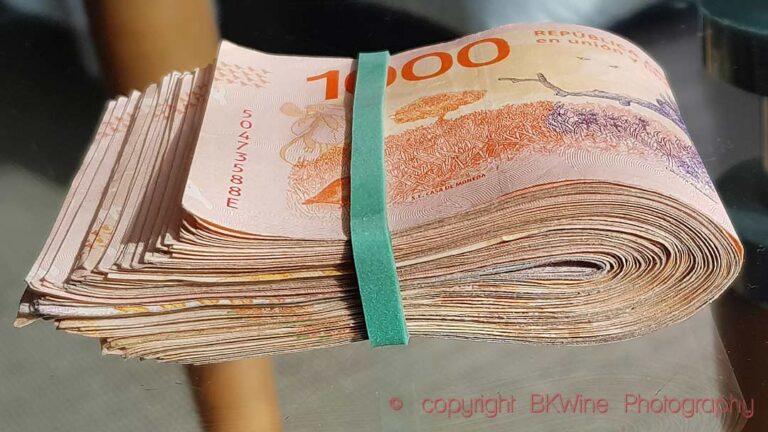How much wine did we drink in 2020? Much more due to covid? Which are the countries that drink the most wine? Or rephrasing: which are the biggest markets for wine in the world? The total world consumption of wine decreased slightly in 2020 to reach 234 Mhl, a drop of 3%. This is most likely an effect of the covid catastrophe that hit the world. But it is also the third year in a row with shrinking consumption.
The biggest wine market remains the USA, followed by France and Italy. However, well over half of all wine is consumed in Europe. In the following article, we will look at consumption per capita.
Read all our articles in the Wine Global 2020 series here:
- Global wine production 2020
- The World’s vineyard surface 2020
- How important is wine production to a country?
- The world’s most productive wine producing countries
- World wine consumption in 2020
- Wine consumption per person in 2020
- World wine exports in 2020
- World wine imports in 2020
- Wine exports compared to total production (dependency on exports)
- Wine exports compared to GDP and to total exports
- Average price per litre on export, by country
- Exports in bottle, sparkling, bag-in-box, bulk in 2020
This is a longer version of an article published on Forbes.com.
Data comes from the OIV, the International Organisation of Vine and Wine, unless otherwise noted.
Global wine consumption in 2020
The world’s wine consumption in 2020 was 234 million hectolitres (Mhl), according to OIV estimates. This marks a decline of 3% (7 Mhl) compared to 2019. It is the third year in a row that consumption has gone down. It is the lowest level since 2002.
The three biggest wine consuming countries, or in other words, the biggest markets for wine, are:
- USA
- France
- Italy
But 2020 is not a typical year, so some caution may be needed when looking at the data.
2020 was marked by the global crisis caused by the covid-19 virus, the worst world crisis in more than a generation. The OIV notes that the decline we see now is similar to the one we saw during the financial crisis of 2008-2009. There is one big difference though. The decline in 2020 follows on to two preceding years of decline, which was not the case when we had the financial crisis.
The 2008 financial crisis was followed by a steep decline in consumption the following year, 2009, and a more modest decline in 2010. So, if there really is a parallel to the 2008 financial crisis, then we should brace ourselves for one or two more years of decline after 2020, totalling five years of shrinking consumption. That would not be good news for the wine industry.
This article on wine consumption should be read with some additional caution, though, not only due to the uncertainty of the crisis. Wine consumption is much harder to track than production or trade. Consumption statistics are notoriously difficult to get right. In addition, China is again a big question mark, or, as the OIV says: “a notable revision in Chinese wine consumption has made China the key driver in lowering consumption levels in the last few years.”
The biggest wine consuming countries
The top ten wine consuming countries with the estimated total consumption in millions of hectolitres:
World’s biggest wine consuming countries (wine markets)
| rank | Country | Consumption, million hl |
|---|---|---|
| 1 | USA | 33 |
| 2 | France | 24.7 |
| 3 | Italy | 24.5 |
| 4 | Germany | 19.8 |
| 5 | UK | 13.3 |
| 6 | China | 12.4 |
| 7 | Russia | 10.3 |
| 8 | Spain | 9.6 |
| 9 | Argentina | 9.4 |
| 10 | Australia | 5.7 |
The USA became the world’s biggest wine market in 2013, when it passed France. It is now much bigger than France.
The French and the Italian wine market, in second and third place, are virtually identical in size.
The five biggest wine consuming countries gulp down half of the world’s wine (49%).
Europe: stable, and drinking more than half of all wine
The EU drank 112 Mhl of wine in 2020, stable since 2019. This is 48% of the world’s wine consumption. So, if we look at the EU as a single market, it is by far the largest. Unfortunately, the EU is not quite a “single market”, especially when it comes to wine, that suffers various trade barriers even within the EU.
Add to that a few more countries: the UK, Russia and Switzerland, and it adds up to 138 Mhl. This then means that Europe (not only the EU) roughly represents 59% of the world’s wine consumption.
That the consumption in the EU remained stable is mainly thanks to the Italians who increased their wine drinking by +7.5%. Will Italy overtake France in 2021 and become the world’s second-biggest wine consumer?
Most other countries actually drank less in 2020 than in 2019.
The exceptions were France and Germany, which were stable, whereas Austria and the Czech Republic drank slightly more.
This is perhaps surprising, considering that one often hears it said that the dreary social distancing, due to the pandemic, led to that we drank more. Apparently, this is not the case. Perhaps the explanation is that the increased wine drinking at home is more than offset by lower consumption in restaurants.
The details for the main European Union countries:
The biggest wine consuming countries in the EU
| rank | Country | consumption, million hl | change on 2019 |
|---|---|---|---|
| 1 | France | 24.7 | 0% |
| 2 | Italy | 24.5 | 7.50% |
| 3 | Germany | 19.8 | 0.20% |
| 4 | Spain | 9.6 | -6.80% |
| 5 | Portugal | 4.6 | -0.60% |
| 6 | Romania | 3.8 | -1.90% |
| 7 | Netherlands | 3.5 | -0.3 |
| 8 | Belgium | 2.6 | -3.10% |
| 9 | Austria | 2.3 | 2.20% |
| 10 | Sweden | 2.2 | -2.30% |
| 11 | Czech Republic | 2.1 | 2% |
| 12 | Hungary | 1.9 | -10.20% |
France is stable in 2020, but it is down, -7.8% from the five-year average.
Italy is a hair’s-breadth from France, thanks to an increase of 7.5%. Up 10% from the 5-year average.
As for the main European countries outside the EU: the UK increased to a consumption of 13.3 Mhl, +2.2%, Russia downed 10.3 Mhl, +3%, and Switzerland drank 2.6 Mhl, -1.6%.
USA: the world’s biggest wine market
The USA maintained its lead as the biggest wine consumer in the world: 33.0 Mhl, which is the same amount as in 2019. It has been the world’s biggest wine market since 2013.
South America: growing healthily
South America saw good growth numbers in the two biggest markets.
Argentina reached 9.4 Mhl, the same volume as Spain, an increase of 6.5%.
The populous but not quite as wine drinking Brazil consumed 4.3 Mhl, up 18.4% and the biggest volume since 2000.
Chile did not manage more than 1.8 Mhl, an increase of +1.4%. But it is a fifth lower than its five-year average. They make lots of great wines in Chile, but the people in the country seem not yet to have discovered it.
South Africa: plummeting
During long periods in 2020, all sales of alcohol, including wine, was banned in South Africa, so it is not surprising that consumption dropped. And drop it did, dramatically. South African wine consumption reached only 3.1 Mhl, -19.4%, which is 27% under its five-year average and the lowest consumption for twenty years. This is slightly less than the Netherlands and a touch more than Belgium.
Australia: weak
Australia consumed 5.7 Mhl in 2020, a drop, -3.7%, but on par with the five-year average.
China: a big drop
China’s wine consumption is estimated to be 12.4 Mhl, a significant drop, -17.4%. This is the third year in a row that consumption declined. Is it time to revise the view of China as “the next big wine market”? But it should be noted that statistics from China have high uncertainty.
Japan: rock solid
Consumption in Japan, the second-biggest market in Asia, reached 3.5 Mhl, just over a quarter of how much the Chinese down, which has been stable for seven years.
Health effects?
It would be interesting to see if the dramatic drop in some countries, notably South Africa, will have any noticeable health effects. Total wine consumption is often taken as an important measure by the anti-alcohol lobby.
Wine consumption in major countries, all details
Wine consumption in countries with more than 2 Mhl total consumption:
| Rank | Country | Consumption, Mhl, 2020 | 20/’19 % | as % of world | cumul. | 2019 | 2018 | 2017 | 2016 |
|---|---|---|---|---|---|---|---|---|---|
| 1 | USA # | 33.0 | 0% | 14% | 14% | 33 | 32.4 | 31.5 | 31.3 |
| 2 | France | 24.7 | 0% | 11% | 25% | 24.7 | 26 | 28.6 | 28.3 |
| 3 | Italy | 24.5 | 8% | 10% | 35% | 22.8 | 22.4 | 22.6 | 22.4 |
| 4 | Germany | 19.8 | 0% | 8% | 43% | 19.8 | 20 | 19.7 | 20.2 |
| 5 | UK # | 13.3 | 2% | 6% | 49% | 13 | 12.9 | 13.1 | 12.9 |
| 6 | China # | 12.4 | -17% | 5% | 54% | 15 | 17.6 | 19.3 | 19.2 |
| 7 | Russia # | 10.3 | 3% | 4% | 58% | 10 | 9.9 | 10.4 | 10.1 |
| 8 | Spain | 9.6 | -7% | 4% | 62% | 10.3 | 10.9 | 10.5 | 9.9 |
| 9 | Argentina | 9.4 | 7% | 4% | 66% | 8.9 | 8.4 | 8.9 | 9.4 |
| 10 | Australia | 5.7 | -4% | 2% | 68% | 5.9 | 6 | 5.9 | 5.4 |
| 11 | Portugal | 4.6 | -1% | 2% | 70% | 4.6 | 5.1 | 5.2 | 4.7 |
| 12 | Canada # | 4.4 | -6% | 2% | 72% | 4.7 | 4.9 | 5 | 5 |
| 13 | Brazil | 4.3 | 18% | 2% | 74% | 3.6 | 3.3 | 3.3 | 3.1 |
| 14 | Romania # | 3.8 | -2% | 2% | 76% | 3.9 | 3.9 | 4.1 | 3.8 |
| 15 | Netherlands # | 3.5 | 0% | 1% | 77% | 3.5 | 3.6 | 3.7 | 3.6 |
| 16 | Japan # | 3.5 | -1% | 1% | 78% | 3.5 | 3.5 | 3.5 | 3.5 |
| 17 | South Africa | 3.1 | -19% | 1% | 79% | 3.9 | 4.3 | 4.5 | 4.4 |
| 18 | Switzerland | 2.6 | -2% | 1% | 80% | 2.7 | 2.6 | 2.7 | 2.7 |
| 19 | Belgium # | 2.6 | -3% | 1% | 81% | 2.7 | 2.7 | 2.8 | 2.8 |
| 20 | Austria # | 2.3 | 2% | 1% | 82% | 2.3 | 2.4 | 2.4 | 2.4 |
| 21 | Sweden | 2.2 | -2% | 1% | 83% | 2.3 | 2.3 | 2.3 | 2.4 |
| 22 | Czech Republic # | 2.1 | 2% | 1% | 84% | 2.1 | 2.1 | 2.2 | 2.1 |
| 98 | Other countries | 32.2 | -15% | 14% | 98% | 37.7 | 37.3 | 33.1 | 34.8 |
| 99 | World total | 234 | -3% | 100% | 241 | 244 | 246 | 244 |
# = OIV estimates
Sources (as per OIV): OIV, IWSR, FAO, Press
Notes:
- 98 and 99 rank is just for sorting purposes
- The 2020 numbers are “preliminary”
- The 2019 numbers are “provisional”
- “World cumulative” does not reach 100% due to rounding. It is cumulative when countries are sorted on rank
One can note that wine consumption is much more spread out than wine production:
- Top 10:
- Wine producers = 83% of total
- Wine consumers = 68% of total
- Top 19
- Producers = 94%.
- Consumer countries = 81%
You can get a more long-term perspective reading our previous articles, for example, these:
















